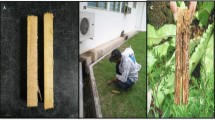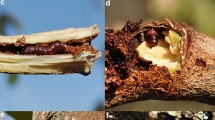Abstract
The termite Nasutitermes corniger is attracted to weathered wood, but it is not known whether this attraction is of chemical or physical nature. This work examines whether wood extracts can change the attraction of N. corniger to a food substrate. In a first experiment, filter paper impregnated with a eucalyptus extract, Eucalyptus grandis, and another one with a solvent were placed in the foraging arena of N. corniger nests under laboratory conditions. The extracts used were from weathered or unweathered wood. During the second experiment, two tests were performed using eucalyptus wood. First, a piece of unweathered wood was impregnated with an extract of weathered wood (treatment) or solvent (control). In the second test, a piece of weathered wood was impregnated with an extract of unweathered wood (treatment) and another one with solvent (control). At the end of the tests, the number of termite recruitment on each substrate was quantified. Filter paper recruited more termites when treated with unweathered wood extracts or with extracts of weathered wood than when impregnated with the solvent. Unweathered wood treated with extracts of weathered wood recruited more termites than the control. However, weathered wood impregnated with extracts of unweathered wood recruited similar numbers of termites as the same wood impregnated with the solvent. It was verified that chemicals from weathered or unweathered wood increased the foraging activity of N. corniger in neutral substrates, but only chemicals from weathered wood altered the attraction of N. corniger to eucalyptus wood.


Similar content being viewed by others
References
Amburgey TL (1979) Review and checklist of the literature on interactions between wood-inhabiting fungi and subterranean termites: 1960–1978. Sociobiology 4:279–296
ASTM D-1107 (1994a) Standard test method for alcohol-benzene solubility of wood. American Society for Testing and Materials, Annual Book of ASTM standards: wood. Philadelphia, 04(10):189–190
ASTM D-1108 (1994b) Standard test method for dichloromethane solubles in wood. American Society for Testing and Materials, Annual Book of ASTM standards: wood. Philadelphia, 04(10):191–192
Bandeira AG, Gomes JI, Lisboa PLB, Souza PCS (1989) Insect pests of wood of buildings in Belém—Pará. EMBRAPA-CPATU. Res Bull 101:1–25 (in Portuguese)
Bandeira AG, Miranda CS, Vasconcellos A (1998) Termite damage in Joao Pessoa, Paraiba—Brasil. In: Fontes LR, Berti Filho E (eds) Termites: the challenge of knowledge. Fealq, Piracicaba, pp 75–85 (in Portuguese)
Bernklau EJ, Fromm EA, Judd TM, Bjostad LB (2005) Attraction of subterranean termites (Isoptera) to carbon dioxide. J Econ Entomol 98(2):476–484
Blanchette RA (1984) Screening wood decayed by white rot fungi for preferential lignin degradation. Appl Environ Microbiol 48:647–653
Broadbent S, Farr M, Bernklau EJ, Siderhurst MS, James DM, Bjostad LB (2006) Field attraction of termites to a carbon dioxide-generating bait in Australia (Isoptera). Sociobiology 48(3):771–779
Bustamante NCR (1998) Nutritional attractiveness of wood-feeding termites inhabiting floodplain forest of the Amazon river, Brazil. Acta Amaz 28:301–307
Carter FL, Jones SC, Mauldin JK, Camargo CCR (1983) Responses of Coptotermes formosanus Shiraki to extracts from five Brazilian hardwoods. Angew Entomol 95:5–14
Cornelius ML, Daigle DJ, Connick WJ Jr, Parker A, Wunch K (2002) Responses of Coptotermes formosanus and Reticulitermes flavipes (Isoptera: Rhinotermitidae) to three types of wood rot fungi cultured on different substrates. J Econ Entomol 95:121–128
Cornelius ML, Daigle DJ, Connick WJ Jr, Williams KS, Lovisa MP (2003) Responses of the formosan subterranean termite (Isoptera: Rhinotermitidae) to wood blocks inoculated with lignin-degrading fungi. Sociobiology 41:513–525
Cornelius ML, Bland JM, Daigle DJ, Williams KS, Lovisa MP, Connick WJ Jr, Lax AR (2004) Effect of a lignin-degrading fungus on feeding preferences of formosan subterranean termite (Isoptera: Rhinotermitidae) for different commercial lumber. J Econ Entomol 97:1025–1035
Costa-Leonardo AM (2002) Termite plague: morphology, biology and control. Divisa, Rio Claro, São Paulo, Brazil (in Portuguese)
Costa-Leonardo AM, Thorne BL (1995) Baits and other alternative methods for termite control. In: Berti Filho E, Fontes LR (eds) Some current aspects of the biology and control of termites. Fealq, Piracicaba, pp 89–94 (in Portuguese)
Esenther GR, Beal RH (1979) Termite control: decayed wood bait. Sociobiology 4:215–222
Esenther GR, Allen TC, Casida JE, Shenefelt RD (1961) Termite attractant from fungus-infected wood. Science 134(3471):50
Gazal V, Bailez O, Viana-Bailez AM (2010) Wood preference of Nasutitermes corniger (Isop. Termitidae). Sociobiology 55:433–443
Gazal V, Bailez O, Viana-Bailez AM, Aguiar-Menezes EL, Menezes EB (2012) Decayed wood affecting the attraction of the pest arboretum termite Nasutitermes corniger (Isoptera: Termitidae) to resource foods. Sociobiology 59:287–295
Grace JK, Wood DL, Frankie GW (1989) Behavior and survival of Reticulitermes hesperus Banks (Isoptera: Rhinotermitidae) on selected sawdusts and wood extracts. J Chem Ecol 15:129–139
Kirk TK (1983) Degradation and conversion of lignocelluloses. In: Smith JE (ed) The filamentous fungi. Edward Arnold, London, pp 266–295
Lepage ES (1986) Manual wood preservation. IPT, São Paulo (in Portuguese)
Mariconi FAM, Fontes LR, Araújo RL (1999) Termites. In: Mariconi FAM, Fontes LR, Araújo RL (eds) Insects and other invaders of homes. Fealq, Piracicaba, pp 35–90 (in Portuguese)
Mill AE (1991) Termites as structural pest in Amazonia, Brazil. Sociobiology 19:339–348
Morales-Ramos JA, Rojas MG (2003) Formosan subterranean termite feeding preference as basis for bait matrix development (Isoptera: Rhinotermitidae). Sociobiology 41(1):71–79
Morales-Ramos JA, Kloch MA, Wrigth M (2001) Three fungal species isolated from Coptotermes formosanus (Isoptera: Rhinotermitidae) bodies, carton material, and infested wood. Fla Entomol 84(1):156–158
Ohmura W, Tokoro M, Tsunoda K, Yohimura T, Takahashi M (1995) Termite trail-following substances produced by brown-rot fungi. Mater Organ 29:133–146
Oliveira JT, Tomasello M, Silva JC (2005) Natural resistance of the wood of seven eucalyptus species to decay. Rev Árvore 29:993–998 (in Portuguese)
Price PW (1984) Insect ecology. Wiley, New York
Rojas MG, Morales-Ramos JA (2001) Bait matrix delivery of chitin synthesis inhibitors to the formosan subterranean termite (Isoptera: Rhinotermitidae). J Econ Entomol 2:506–510
Rojas MG, Morales-Ramos JA (2003) Field evaluation of nutritionally-based bait matrix against subterranean termites (Isoptera: Rhinotermitidae). Sociobiology 41(1):81–90
Rojas MG, Morales-Ramos JA, Green (2003) Naphthalenic compounds as termite bait toxicans. US Patent & Rojas MG
Rust MK, Haagsma K, Nyugen J (1996) Enhancing foraging of western subterranean termites (Isoptera: Rhinotermitidae) in arid environments. Sociobiology 28:275–286
Su N-Y (1994) Field evaluation of hexaflumuron bait for population suppression of subterranean termites (Isoptera: Rhinotermitidae). J Econ Entomol 87:389–397
Su N-Y (2005) Directional change in tunneling of subterranean termites (Isoptera: Rhinotermitidae) in response to decayed wood attractants. J Econ Entomol 98:471–475
Su N-Y, Scheffrahn RH (1993) Laboratory evaluation of two chitin synthesis inhibitors, hexaflumuron and diflubenzuron, as bait toxicants against the Formosan subterranean termite (Isoptera: Rhinotermitidae). J Econ Entomol 86:1453–1457
Su N-Y, Scheffrahn RH (1998) A review of subterranean termite control practices and prospects for integrated pest management programs. Integr Pest Manag Rev 3:1–13
Suoja SB, Lewis VR, Wood DL, Wilson M (1999) Comparisons of single and group bioassays on attraction and arrestment of Reticulitermes sp. (Isoptera: Rhinotermitidae) to selected cellulosic materials. Sociobiology 33:125–135
Waller DA, La Fage JP (1987) Nutritional ecology of termites. In: Slansky F, Rodriguez JG (eds) Nutritional ecology of insects, mites, and spiders. Wiley, New York, pp 487–532
Watanabe T, Casida JE (1963) Response of Reticulitermes flavipes to fractions from fungus-infected wood and synthesis chemicals. J Econ Entomol 56:300–307
Wolcott GN (1957) Termite-repellent wood extractives. J Agric Univ P R 37:224–227
Wood TG (1978) Food and feeding habits of termites. In: Brian MV (ed) Production ecology of ants and termites. Cambridge University Press, Cambridge, pp 55–80
Acknowledgments
We thank Pamella Rosa and Arli de Fátima for technical support in the laboratory. This research was funded by CAPES and CNPq.
Author information
Authors and Affiliations
Corresponding author
Rights and permissions
About this article
Cite this article
Gazal, V., Bailez, O., Viana-Bailez, A.M. et al. Behavioral responses of the arboreal termite Nasutitermes corniger (Isoptera: Termitidae) to wood extracts. Wood Sci Technol 48, 581–590 (2014). https://doi.org/10.1007/s00226-014-0625-4
Received:
Published:
Issue Date:
DOI: https://doi.org/10.1007/s00226-014-0625-4




